How to select the right security turnstile for your project?
Security turnstiles have developed into a significant and efficient entrance control solution for large venues, whether the follow of people is high and safety is of utmost importance. They are designed to prevent crowding and make the passages convenient for everyone. However, there are so many security turnstile gates available, each with a unique set of features and capabilities tailored to a particular application. Typically, some turnstile gates are ideal for some applications but not for others. When choosing products for an installation, it is essential to realize that not all electronic turnstiles are created equally.
In general, Some of the following factors should be emphasized because different security turnstiles often have distinct features to match different project needs.
Height: In general, selecting a turnstile will be the best for a project based on the level of security required. Full-height turnstiles are the best option for those projects requiring a high level of security. Contrarily, if a project calls for waist-high levels of security, waist-high turnstiles and optical turnstiles are the ideal choices.
Handicap Access: To ensure equal access for people with physical disabilities (pedestrians using wheelchairs, crutches, walkers, etc.), some projects typically call for handicap access. To comply with ADA regulations, your access control system needs to include an ADA turnstile device. The majority of projects use a combination of ordinary turnstiles and one ADA-compliant gate to grant entry to both regular and disabled visitors.
Aesthetics: Some automatic turnstiles and handicap-accessible turnstiles are created primarily with aesthetics, and others are built to be tough and tamper-proof while paying little regard to aesthetically pleasing design. On the other hand, some others are toward the middle of the aesthetics spectrum, emphasizing both design and usefulness. Whether a security turnstile will be visually beautiful or not depends on a number of factors, including the complexity of the design, the materials used, the polish, and the sophistication. The greatest product to select is one that will fit in with its surroundings. There is always a turnstile gate with an appropriate level of aesthetics, regardless of the surroundings—whether they are in a chic high-rise office building or a grimy construction site.
Security: The level of security is one of the most crucial considerations when specifying an access control project. It is determined by numerous elements, including turnstile height, tamper-proof properties, physical barrier-locking properties, and more. Products range from barrier-free optical turnstiles that just detect when people pass through rather than physically stopping them to full-height turnstiles that provide unmatched security. It is important to assess your security needs before choosing a turnstile or gate for your job because there are many options ranging from high to low security.
Before choosing a turnstile access control system, make sure your project situation and the unique criteria are as follows are as follows
1. What are the turnstiles and where are they used?
A security turnstile is an electro-mechanical access barrier used to prevent illegal access to protected areas and, when necessary, to identify and record each individual who enters and exits. Such access control turnstile manages entry while simultaneously recording the times of attendance and total working hours of each employee. Knowing the amount of security needed will help determine whether a manually rotating tripod turnstile, a full-height turnstile, or only individualization without any authentication of the person’s identity is needed.
2. What environment is for the turnstile?
Some turnstiles are suitable for indoor or outdoor applications, and others are designed with a specific application, so it is very important to know the environmental conditions of your project before finalizing the turnstile type.
3. Will your turnstile be located in a corrosive environment? (snow, wind, rain, salt, etc.)
If so, a model composed of 316 stainless steel probably offers the finest defense against corrosive environments.
4. Is ADA access necessary?
Please confirm with your project manager in advance as some projects require ADA access control for people with disabilities and pedestrians carrying a lot of luggage, while others do not. For this kind of traffic, several of our turnstiles can either be paired with a full-size ADA passage gate, be purchased in an ADA-compliant model, or offer flexible-width passing lanes. This typical compliance requirement is a crucial factor.
5. How many people need to pass through the entry point in what amount of time?
Choosing the appropriate model and quantity are crucial considerations when figuring out what will ultimately work as a crowd management system. A realistic approximation/average for how long it takes for a person with ID to pass through a turnstile is five seconds.
6. What are the ways to control the turnstile?
The turnstile can be managed in a number of different ways:
Manually- requiring a user, such as a security guard or a receptionist;
Automatically – Identification, such as proximity cards, keypads, or RFID tags for access control, are used to implement automatic control.
Biometric access systems – cutting-edge control solutions that use biometrics (facial recognition technology, retinal scanning, fingerprint readers, etc.) to identify the user.
7. What are the turnstile functions?
Turnstile functions can be varied. There are basic models that just aid in facilitating orderly admission through an entrance in commercial or recreational facilities, where a receptionist or security guard manually admits visitors or employees after scrutinizing their identification cards. There are also fairly sophisticated and multifaceted solutions that recognize an entrant by reading a card or biometric features. These can provide automated accounting of the attendance habits of employees or guests by automatically entering the time of arrival and departure into a database.
The types of Access Control Turnstile Gates
Optical turnstiles come with or without an entry barrier like an arm or a swing gate. To determine whether a person is authorized to pass, they mostly employ infrared sensors. Alarms and security cameras are audio and visual interfaces that detect intruders. When aesthetics are important indoors, optical turnstiles are frequently used.
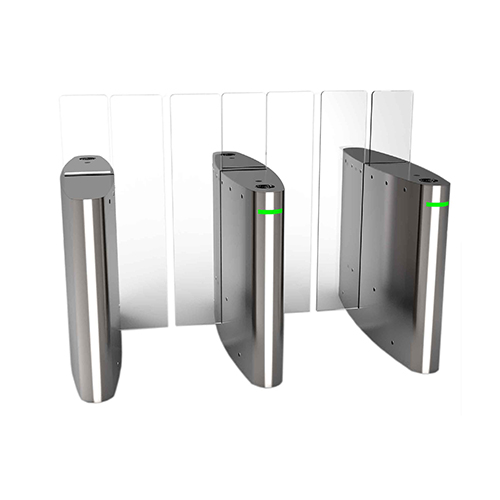
Tripod turnstile gates are the most widely used access control method in schools, which are affordable and simple to use. They may be used both indoors and outdoors and allow for bidirectional circulation. Tripod turnstiles have a wide margin of safety and reliability, and they perfectly handle unwanted admission. The speed of student movement via turnstiles for schools is important. The tripod arm can move up to 30 people per minute and can easily handle heavy traffic. To enable open or restricted access, the tripod turnstiles are simple to integrate with any traditional access control system. Most of them permit free evacuation in case of an emergency, power outage, or as necessary by the administrative systems. They provide safe and practical passage at companies, plazas, factories, schools, etc.
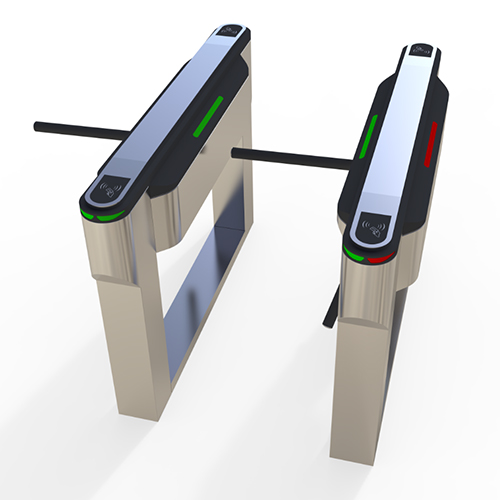
Full-height turnstile gates are physical access control solutions that provide floor-to-ceiling protection. Due to their full size and robust construction, they are practically impenetrable and built of enduring steel. These turnstiles consist of a vertical central post with perpendicular arms extending out in three different directions, all enclosed in a cage that only allows one person to pass through at once. Full-height turnstiles are frequently utilized for high-security events and are available at military bases, jails, construction sites, and other locations. They are created for locations where utmost security is necessary and are enormous turnstiles with several rotating barriers. They are low-maintenance, practical, and built for large spaces. they provide both one-way and bidirectional passage, are widely utilized in power plants, oil refineries, data centers, stadiums, parks & prisons, and are simple to integrate with industry-leading access control systems.
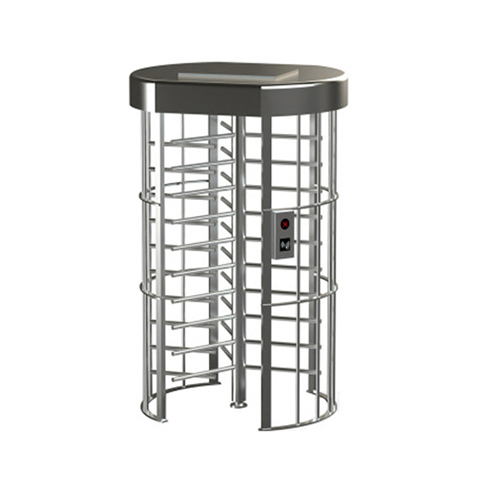
Swing gate turnstiles contain the following characteristics and are more frequently employed as auxiliary access control systems: When a specific signal is received, the gate will automatically open and stay open, allowing multiple people to pass through at once. The safety of such access control turnstiles is achieved by limiting the static entrapment force of the blade as they lack presence sensors and do not respond to a user in the corridor. Swing turnstile gates have the advantage of providing access to trolleys and the transportation of large objects, as well as acting as an emergency exit in the event of an alarm. Their blades can be over 900 mm broad.

Speed gate turnstiles are a more technological and fashionable solution suitable for universities, private schools, and lyceums. They fit perfectly into the interior and manage to organize a large flow of pedestrians. This type of turnstile can work only indoors. Such turnstiles are best suited for aesthetically demanding spaces like bank headquarters, plazas, and office buildings. The speed gate housing comes with built-in electronics that can be easily integrated with conventional access control systems to manage visitors. The speed gate comes with plexiglass barriers, which come in sliding and swinging motion or extra high glasses for safety.

Waist High ADA Gates
Waist-high ADA gates are swinging gates with ADA-compliant lane widths to permit wheelchair access that is the same height as waist-high turnstiles. They have glass barriers or arms that can swing open to allow access or remain closed to deny access. To allow a handicap-accessible entrance or exit from a facility without significantly compromising entrance security, waist-high ADA gates are frequently combined with corresponding waist-high turnstiles. They are present at stadiums, metro networks, amusement parks, and other places.
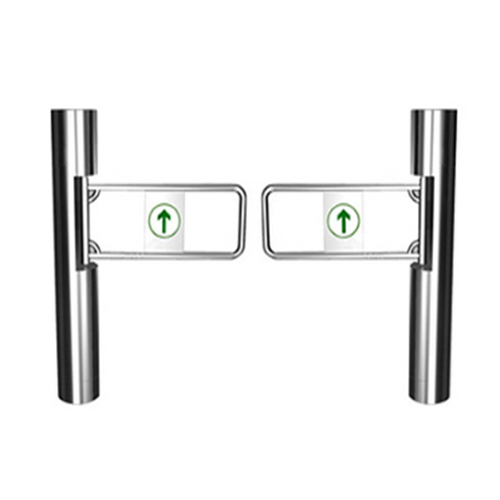
Full Height ADA Gates
Similar to waist-high ADA gates, full-height ADA gates are frequently combined with full-height turnstiles to offer an entry control system that is both safe and disability accessible. These gates frequently have the same appearance as their full-height turnstile counterparts and extend from floor to ceiling. They are fantastic for upholding a high level of security while still adhering to ADA guidelines. Full-height gates are often used anywhere a full-height turnstile is used like at correctional facilities, construction sites, military bases, and more.
Factors to consider while choosing a turnstile gate
Number of turnstiles (lanes)
How many lanes are needed is one of the questions we ask end-users frequently. In order to establish the number of lanes needed, you must essentially look at the number of permitted occupants (cardholders) or the projected number of users. At the minimum, there must be two lanes in each direction or one lane with a turnstile gate that opens in both directions.
Passage Directions and Throughput rate
Most of the optical turnstiles allow access in both directions once the user authenticates their identity via a card reader, biometrics, etc.,
Depending on the needs of the client, turnstile gates can be designed to enable access from either way. The throughput rate necessary per lane per minute is another crucial consideration. You should select turnstiles that can process more than 40 persons per minute for congested transportation hubs.
Fail-Safe functionality
Turnstile gates’ fail-safe operation, a crucial security element, enables gate unlocking in the event of a fire alarm or a power outage. The turnstiles’ technical requirements should also be taken into consideration; for example, its anti-panic mechanism permits unimpeded passage in the event of a power outage or other emergency. For tripod turnstiles, an anti-panic barrier arm automatically drops to offer free passage
Mechanical anti-panic feature
The mechanical anti-panic arm in the tripod turnstile allows security personnel or users to lower the foldable arm of a tripod in case of an emergency or power failure. Unlike fail-safe features, the anti-panic operation does not have to be integrated with the fire alarm system.
Built-in Sensors
You can precisely identify a person who tries to follow the person by using infrared sensors built into the speed gate turnstile or ones that are optionally supplied. It makes it possible for the glass wings on automatic gates to close quickly. These intelligent sensors are also used by access control turnstile gates to identify unwanted entry attempts. On the turnstile pole, the sensors are mounted at two different levels.
Aesthetics and accessories
Security turnstile is installed considering the surroundings and the required level of access control. Constructing a customized turnstile entrance system is one fantastic technique to highlight the architectural features of the building, including color options, bespoke finishing, LED wing, relay signal options, etc.
 Double Lane Full Height Turnstile Gate for Residential Area
Double Lane Full Height Turnstile Gate for Residential Area
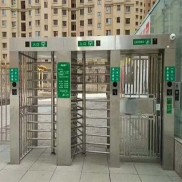 Dual Lane Tandem Full Height Turnstile Gate for Industry Park
Dual Lane Tandem Full Height Turnstile Gate for Industry Park
 Single Full Height Security Turnstile for Office Buildings
Single Full Height Security Turnstile for Office Buildings
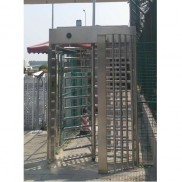 Motorised Double Full-Height Turnstile for Office Buildings
Motorised Double Full-Height Turnstile for Office Buildings








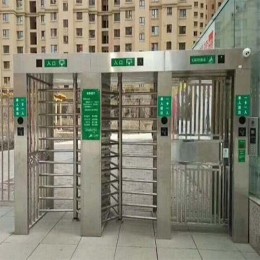







Please leave a message if you are interested in this model